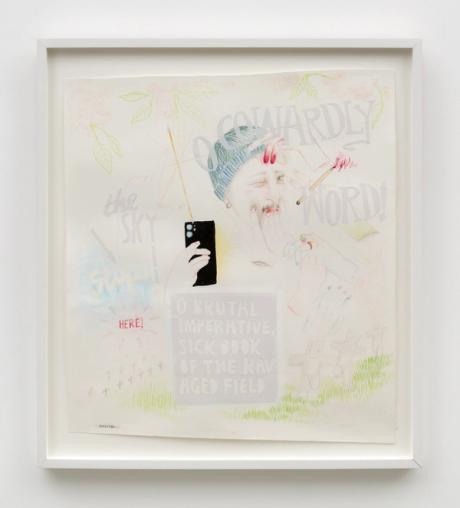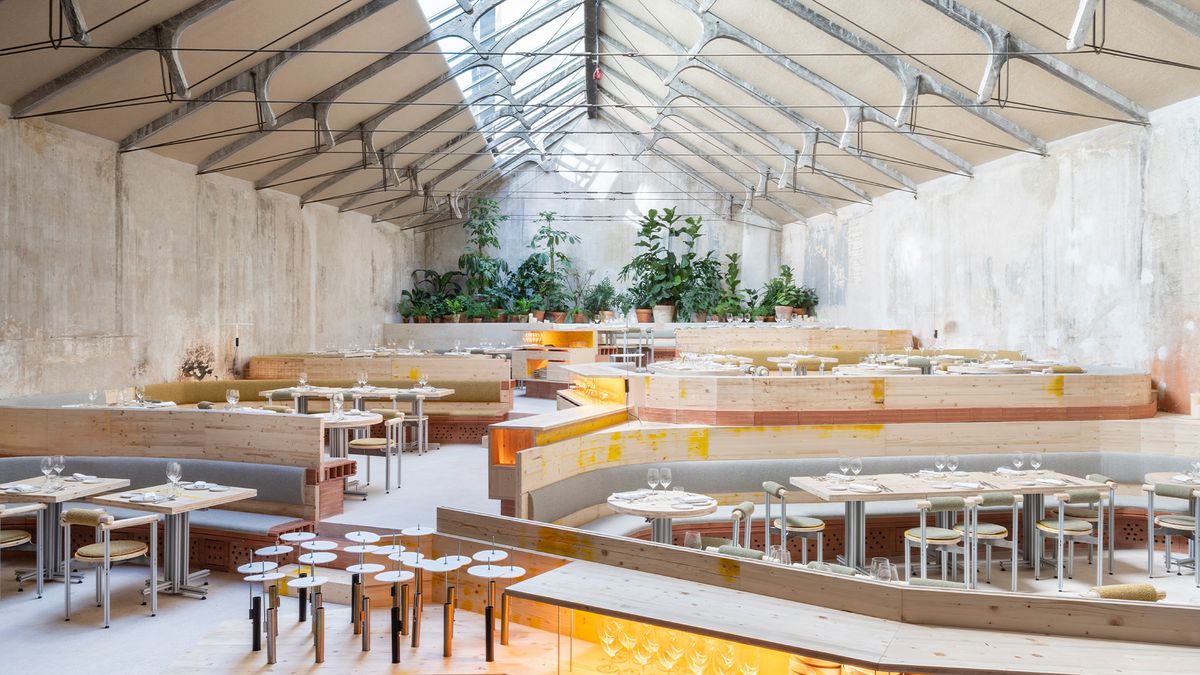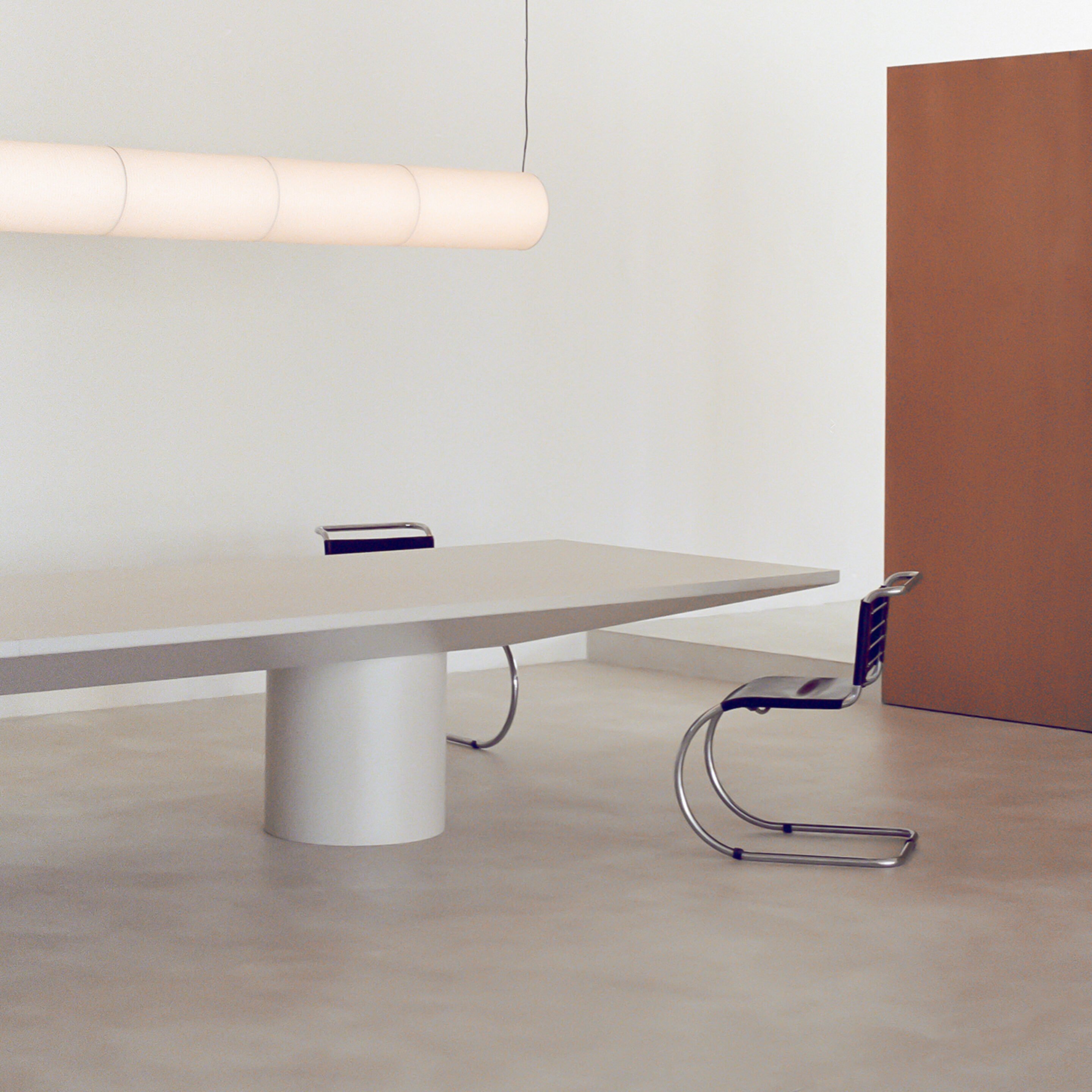Fairy #2
2011 - Painting (Painting)
Masaya Chiba
Fairy #2 (2011) depicts a surreal scene of roughly assembled household ephemera, potted plants, and a faintly visible figure rendered in thin red line. The picture shows a grouping of tables and stools arranged in a dense cluster. A collection of objects, all brown or burlap-hued, cover their surfaces: ceramic pots, wooden planks, roughly geometric wooden sculptures, and even a small figure that perches precariously atop of miniature cube alongside a forked wood finish form. Chiba’s use of a nearly monochromatic palette makes it difficult to discern many of these objects, and they only become recognizable from their faint resemblances to things in real life. The picture’s monochromatic field, however, is interrupted by color three times: by the French blue finish of a stool positioned in the background, by the leafy green foliage of two potted plants, and by the nearly imperceptible red line drawing of a figure superimposed over the dense assemblage in the foreground. Presumably the “fairy” of the work’s title, the red figure looks towards the viewer with soft eyes and a delicate smile and at first glance appears benevolent. Chiba, however, renders the fairy into a violently contorted posture, its arms and legs twisted to conform along the shape of the objects piled behind it. Alternately playful and curiously violent, Fairy #2 offers a dreamlike image that is at once reminiscent of bedtime stories and apocalyptic fears. In this context, the “fairy” could be seen as an imaginatively playful creature, but it could also be read as an allusion to the faint bodily outlines left behind during the nuclear bombing attacks on Hiroshima and Nagasaki during World War II.
Masaya Chiba utilizes painting, sculpture, and installation to create dreamlike works that respond to Surrealism traditions while also exploring the limits of representation and translation. Many of his paintings begin as assemblages in his studio, and in preparing these installations, Chiba collects seemingly random assortments of objects – photographs, wooden planks, potted plants, excess paint – to stage unusual material landscapes. Other objects used in his paintings are also drawn from memory, suggesting an illusory attempt to recapture objects and experiences that no longer exist in the present. Once configured into a desired form, Chiba utilizes these installations and objects as studies for his richly rendered oil paintings. Seemingly whimsical at first glance, his pictures also suggest an undercurrent of anxiety and instability, as if the perceptible world was melting away below us.
Colors:
Related works sharing similar palette

© » KADIST
Rodrigo Torres
2016In his Conceito abstrato series, however, Rodrigo Torres turns to the abstract, using the shapes, numbers, lines, and subtle colors of international currencies to create non-representational forms with lavish geometries and baroque curving forms....

© » KADIST
Marcelo Cidade
2010Marcelo Cidade’s sculpture Abuso de poder (Abuse of Power, 2010) is a mousetrap elegantly crafted in Carrara marble...

© » ARTS EQUATOR
Latiff Mohidin’s “Langkawi”: The Within and Beyond | ArtsEquator Thinking and Talking about Arts and Culture in Southeast Asia Articles Image: Chan + Hori Gallery July 10, 2018 By Gerald Sim (1,500 words, eight minute read) As with any thought-provoking installation, Latiff Mohidin’s “Langkawi” series, on show at Chan+Hori Contemporary , evokes a large range of perceptions from its audience...

© » KADIST
Asli Çavusoglu
2020In the exhibition Pink as a Cabbage / Green as an Onion / Blue as an Orange , Asli Çavusoglu pursues her work on color to delve into an investigation into alternative agricultural systems and natural dyes made with fruits, vegetables, and plants cultivated by the farming initiatives she has been in touch with...

© » KADIST
Pierre Leguillon
2008End of 2008, Pierre Leguillon presented at KADIST, Paris the first retrospective of the works of Diane Arbus (1923-1971) organized in France since 1980, bringing together all the images commissioned to the New York photographer by the Anglo-American press in the 1960s...

© » LE MONDE
Le jeu d’illusions grinçantes du photographe Jeff Wall, à Bâle Cet article vous est offert Pour lire gratuitement cet article réservé aux abonnés, connectez-vous Se connecter Vous n'êtes pas inscrit sur Le Monde ? Inscrivez-vous gratuitement Article réservé aux abonnés « Boy Falls From Tree » (2010), de Jeff Wall...

© » THEARTNEWSPER
Turner Prize winner Jesse Darling makes a Miami Beach cameo Art market Museums & heritage Exhibitions Books Podcasts Columns Technology Adventures with Van Gogh Search Search Art Basel in Miami Beach 2023 news Turner Prize winner Jesse Darling makes a Miami Beach cameo A self-portrait by Jesse Darling, who won the prestigious British award this week, is on sale at Chapter NY gallery Gareth Harris 9 December 2023 Share Jesse Darling, O Cowardly Word , 2022 Courtesy of the artist and Chapter NY, New York A self-portrait by the Turner prize winner Jesse Darling is available with Chapter NY gallery at Art Basel in Miami Beach...

© » KADIST
Taiyo Kimura
The wall installation Friction/Where is Lavatory (2005) plays off anxieties about time but utilizes sound to create a disconcerting experience of viewership: comprised of dozens of wall clocks sutured together, the work presents a monstrous vision of time at its most monumental...

© » KADIST
Kamau Amu Patton
2011Kamau Amu Patton’s painting Static Field I originates from a system of electronic and digital media...

© » ARTS EQUATOR
The working processes of artists: Sabrina Poon | ArtsEquator Thinking and Talking about Arts and Culture in Southeast Asia Articles April 27, 2020 Singaporean filmmaker Sabrina Poon, better known as Spoon, talks about her work and the value of storytelling by breaking down three of her short films – Sylvia , Hello Uncle and Pa ...









